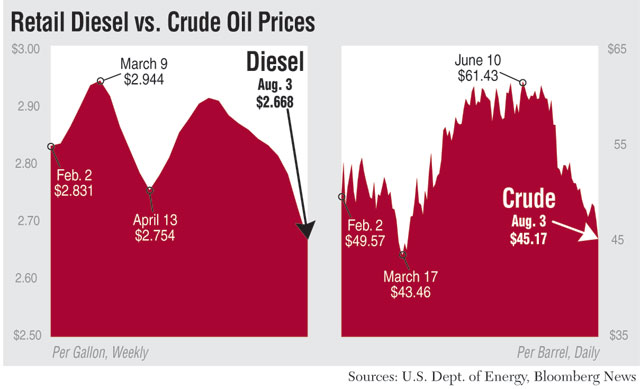Diesel Average Drops for 10th Straight Week, Reaching Lowest Level Since October 2009

The U.S. diesel average declined 5.5 cents last week to $2.668 a gallon, the lowest price since 2009, the Department of Energy reported.
The price of trucking’s main fuel has fallen 10 straight weeks, totaling almost 25 cents. That is the longest period of consecutive falling prices since a 12-week period from Nov. 10, 2014, to Feb. 2, 2015, when the average price plunged 84.6 cents.
Diesel is $1.185 cheaper than a year earlier, DOE reported after its Aug. 3 weekly survey of filling stations.
The current diesel price is also the lowest since Oct. 12, 2009, when diesel was at $2.60.
Since its most recent peak of May 25 at $2.914, diesel has fallen 24.6 cents.
DOE also reported the average retail gasoline price fell 5.6 cents a gallon to $2.689. Prices have dropped 14.6 cents since June 15, and gasoline is 82.6 cents below its level one year ago.
Mike Meehan, vice president of sales at industry analytics firm Fleet Advantage, in Fort Lauderdale, Florida, told Transport Topics he anticipates prices to remain relatively stable into the fall.
He added, however, that diesel fuel pricing over the next 12 to 24 months is not expected to be volatile.
“We don’t see $4 a gallon again soon, but we certainly don’t see it going down below $2.50 or well below $2,” he said.
Meehan said that current price and retail trends have prompted several firms to scale back on investing in alternative fuel technology.
“For the most part, to move 80,000 pounds down the road, they’re all realizing that clean-diesel technology today is better and less expensive than trying to go with an alternative where the technology isn’t there yet,” he said.
Ron Niemoth, chief financial officer at Seward Motor Freight Inc., said he expects prices to remain status quo over the next few months.
He also noted his firm outlines a long-range budget that takes into account possible fluctuations in fuel pricing.
The Seward, Nebraska-based firm operates about 120 tractors and 380 trailers around the country.
“We sure like to see it going down, that’s for sure,” Niemoth said. “I think the most important thing is, you just have to keep good track of where we’ve been and trying to guess where we’re going.”
Meanwhile, the price of crude oil on the New York Mercantile Exchange dropped below $50 a barrel last week for the first time since January. The decline came as Iran vowed to boost production immediately after sanctions are lifted and manufacturing in China slowed.
Michael Wittner, head of U.S. commodities research at Société Générale in New York, told Bloomberg News that political uncertainty in oil-producing countries, as well as global oversupply, have contributed to push down the price of oil.
Helima Croft, chief commodities strategist at RBC Capital Markets in New York, agreed. She added, “Right now, we’re in a race to the bottom. Oil producers are pumping what they can in the hopes that someone else will cut first.”
A survey by Bloomberg News of oil firms, producers and industry analysts found that output by the OPEC oil cartel decreased 362,000 barrels to 32.107 million a day in July.




